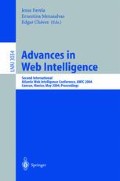Abstract
Due to the open nature of the Web, search engines must include means of meaningful processing of incorrect texts, including automatic error detection and correction. One of wide-spread types of errors in Internet texts are malapropisms, i.e., semantic errors replacing a word by another existing word similar in letter composition and/or sound but semantically incompatible with the context. Methods for detection and correction of malapropisms have been proposed recently. Any such method relies on a generator of correction candidates—paronyms, i.e., real words similar to the suspicious one encountered in the text and having the same grammatical properties. Literal paronyms are words at the distant of few editing operations from a given word. We argue that a dictionary of literal paronyms should be compiled beforehand and that its units should be grammeme names. For Spanish, such grammemes are (1) singulars and plurals of nouns; (2) adjectives plus participles; (3) verbs in infinitive; (4) gerunds plus adverbs; (5) personal verb forms. Basing on existing Spanish electronic dictionaries, we have compiled a dictionary of one-letter-distant literal paronyms. The size of the dictionary is few tens thousand entries, an entry averaging approximately three paronyms. We calculate the gain in number of candidate search operations achievable through the proposed dictionary and give illustrative examples of correcting one-letter malapropisms using our dictionary.
Work done under partial support of Mexican Government (CONACyT, SNI, COFAA-IPN) and Korean Government (KIPA Professorship for Visiting Faculty Positions in Korea). The first author is currently on Sabbatical leave at Chung-Ang University.
Access this chapter
Tax calculation will be finalised at checkout
Purchases are for personal use only
Preview
Unable to display preview. Download preview PDF.
References
Bolshakov, I.A., Galicia-Haro, S.N.: Can We Correctly Estimate the Total Number of Pages in Google for a Specific Language? In: Gelbukh, A. (ed.) CICLing 2003. LNCS, vol. 2588, pp. 415–419. Springer, Heidelberg (2003)
Bolshakov, I.A., Gelbukh, A.: A Very Large Database of Collocations and Semantic Links. In: Bouzeghoub, M., Kedad, Z., Métais, E. (eds.) NLDB 2000. LNCS, vol. 1959, pp. 103–114. Springer, Heidelberg (2001)
Bolshakov, I.A., Gelbukh, A.: On Detection of Malapropisms by Multistage Collocation Testing. In: Dusterhoft, A., Talheim, B. (eds.) 8th Intern. Conference on Applications of Natural Language to Information Systems NLDB 2003, GI-Edition, Bonn. Lecture Notes in In-formatics, vol. P-29, pp. 28–41 (2003)
Hirst, G., St-Onge, D.: Lexical Chains as Representation of Context for Detection and Corrections of Malapropisms. In: Fellbaum, C. (ed.) WordNet: An Electronic Lexical Database, pp. 305–332. The MIT Press, Cambridge (1998)
Kashyap, R.L., Oomen, B.I.: An effective algorithm for string correction using generalized edit distances. I. Description of the algorithm and its optimality. Information Science 23(2), 123–142 (1981)
Mays, E., Damerau, F.J., Mercer, R.L.: Context-based spelling correction. Information Processing and Management 27(5), 517–522 (1992)
Manning, C.D., Schütze, H.: Foundations of Statistical Natural Language Processing. The MIT Press, Cambridge (1999)
Oxford Collocations Dictionary for Students of English. Oxford University Press, Oxford (2003)
Wagner, R.A., Fisher, M.J.: The string-to-string correction problem. J. ACM 21(1), 168–173 (1974)
Biemann, C., Bordag, S., Heyer, G., Quasthoff, U., Wolff, C.: Language-independent Meth-ods for Compiling Monolingual Lexical Data. In: Gelbukh, A. (ed.) CICLing 2004. LNCS, vol. 2945, pp. 214–225. Springer, Heidelberg (2004)
Author information
Authors and Affiliations
Editor information
Editors and Affiliations
Rights and permissions
Copyright information
© 2004 Springer-Verlag Berlin Heidelberg
About this paper
Cite this paper
Gelbukh, A., Bolshakov, I.A. (2004). On Correction of Semantic Errors in Natural Language Texts with a Dictionary of Literal Paronyms. In: Favela, J., Menasalvas, E., Chávez, E. (eds) Advances in Web Intelligence. AWIC 2004. Lecture Notes in Computer Science(), vol 3034. Springer, Berlin, Heidelberg. https://doi.org/10.1007/978-3-540-24681-7_13
Download citation
DOI: https://doi.org/10.1007/978-3-540-24681-7_13
Publisher Name: Springer, Berlin, Heidelberg
Print ISBN: 978-3-540-22009-1
Online ISBN: 978-3-540-24681-7
eBook Packages: Springer Book Archive

